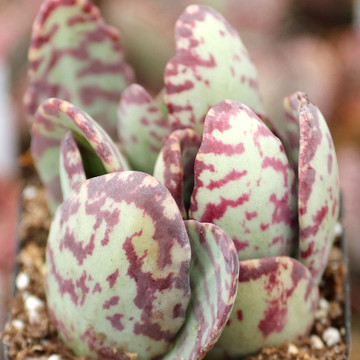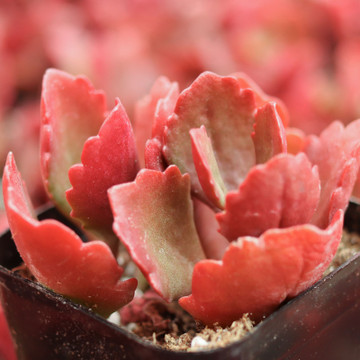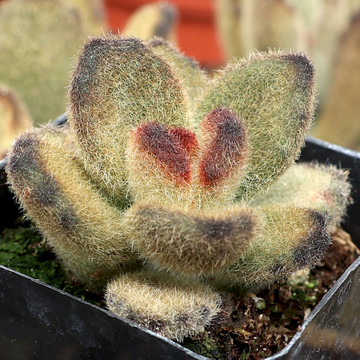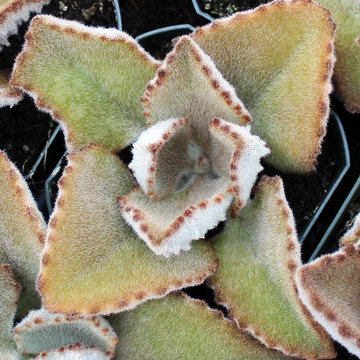Kalanchoe (kal-un-KO-ee) is a group of exotic succulents prized for their unusual foliage and flowers. They are reliably easy to grow and can be almost alien in appearance. Look for large, embellished leaves that can be velvety, toothed, scalloped, or lined with new plantlets.
APPEARANCE
- Colors: A range of shades from glaucous pastels to splashy jewel tones, some with overlay patterns of stripes or spots.
- Form: Kalanchoe varieties included here can range in size from a 3″ groundcover to an upright plant over 12″ tall. Though they have widely different leaf shapes, most are arranged in a loose rosette form.
- Foliage: There is no shortage of interesting leaf shapes here, including wavy paddles, scallop-edged spoons, and deeply-channeled quills. There are several “tomentose” varieties as well that are covered in a soft coating of felt.
- Flowers: Blooming red, pink, orange, yellow, or white, Kalanchoe will erupt in numerous flowers, either hanging and bell-like or upright and open. A few species, including paddle plant (K. luciae), are monocarpic, meaning it will bloom once after several years and then die, though its offsets will live on.
CARE
- Light: Cultivate Kalanchoe in partial sun locations. If keeping indoors, be sure to place the container near a sunny window; you can even bring the pot outdoors in the summer if nighttime temperatures stay above 40F.
- Soil: A light, well-draining soil balanced with organic matter will encourage growth and prevent root rot. Look for a gritty cactus/succulent soil at a garden center or make your own by mixing 1 part potting soil with 1 part coarse sand. Fertilizer is not required, but a biweekly application of a balanced fertilizer in the summer growing season can accelerate growth and prompt flowering.
- Water: Infrequent watering is key to developing healthy roots, especially in the winter when Kalanchoe is not actively growing. Water deeply, but only when the soil is dry, as Kalanchoe will not tolerate standing water. Frequency will vary; aim for about 1-2 times a week in the summer and 2-3 times a month during winter semi-dormancy. For potted Kalanchoe, we recommend using containers with drainage holes.
- Hardiness: Kalanchoe succulents are not frost hardy, so only plant outdoors in Hardiness Zones 9 through 11 with good drainage and plenty of sun (what’s my zone?). Fortunately for plant lovers in other climates, these plants are happy growing indoors.
- Propagation: These varieties can be multiplied through stem or leaf propagation. Use a sharp, clean knife to remove a large leaf or the top 2″+ of stem. Leave the cutting to dry 3-5 days then follow our Guide to Propagating Cuttings to re-root them. For varieties like Mother of Thousands and Chandelier Plant (K. delagoensis), large quantities of plantlets grow from the leaf margins and can simply be transplanted.
NOTES FROM THE NURSERY
Kalanchoe is a quirky, varied group of plants encompassing about 150 species, primarily from Madagascar. Compared to most tender succulents, these plants can tolerate a bit more water, less sun, and higher soil organic matter content. Overall, they are very forgiving growers and will thrive indoors near a bright window.
Keep an eye on the prolific bryophyllum types; aptly named “Mother of Thousands” or even “Mother of Millions”, they will sprout so many plantlets along their leaves that, once planted, you may never get rid of them.
For more information on specific kalanchoe varieties, we recommend these succulent resources:
READ MORE














